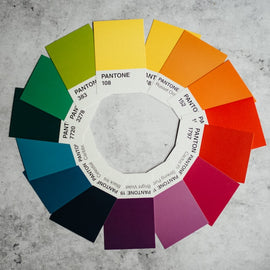Art has the power to elevate the mood and add a personal touch to your home decor. Whether you're a seasoned art collector or just starting out, building the perfect gallery wall can be a daunting task. With so many styles, colors, and mediums to choose from, it's easy to get lost in the process. In this beginner's guide, we'll take you through the step-by-step process of making the perfect gallery wall in your home, from selecting the right art pieces to arranging them on the wall.
Step 1: Define Your Style
When it comes to building the perfect art gallery wall, the first step is to define your style. Your art wall is an extension of your personal style, so it's important to choose pieces that match your vision. Take some time to think about the mood you want to create in your home. Are you looking for a sleek, modern look, or do you prefer a cozy, eclectic vibe? Once you've established your style, you can start looking for art pieces that match your vision.
One way to find inspiration is by flipping through magazines, scrolling through social media, or visiting galleries. This can help you get a sense of the different styles, colors, and mediums that are available. Another great way to find inspiration is to take a closer look at your home decor. Consider the colors and textures of your furniture and walls. You'll want to choose art pieces that complement or match the overall aesthetic of the room.
It's important to keep in mind that you don't have to limit yourself to one style. Mixing and matching different styles can add depth and interest to your art wall. Just be sure to choose pieces that complement each other. When you're selecting your art pieces, pay attention to the colors, textures, and overall feel of the pieces. The key is to choose pieces that resonate with you and that you'll enjoy looking at every day.
Step 2: Choose Your Art
Now that you have a better idea of your style, it's time to choose your art pieces. With so many different types of art to choose from, it can be overwhelming to know where to start. Some of the most popular types of art include paintings, photographs, sculptures, and mixed media pieces. The key is to choose pieces that match your personal style and that you'll enjoy looking at every day.
When selecting your art pieces, consider the size of the pieces and the space you have available. You'll want to choose pieces that are proportional to the wall and the furniture in the room. If you have a large wall, you can choose a larger piece or create a gallery wall with several smaller pieces.
The color and texture of your art pieces are also important factors to consider. You can choose pieces that complement or contrast the colors in the room. If you're looking for a more cohesive look, you can choose pieces with similar colors or textures. It's also a good idea to choose pieces with a range of textures and mediums to add depth and interest to your art wall.
Step 3: Create a Layout
Creating a layout is a crucial step in making the perfect gallery wall. A layout will help you visualize how your art pieces will look on the wall and make it easier to hang your pieces evenly.
To create a layout, start by laying your art pieces on the floor and arranging them in different configurations until you find the perfect one. This will allow you to experiment with different layouts without committing to hanging the pieces on the wall. You can also use a virtual design tool to create a digital layout. This can give you a better idea of how the pieces will look on the wall before you start hanging them.
When creating your layout, pay attention to the spacing between the pieces. You'll want to leave enough space between the pieces to make each one stand out, but not so much that the overall layout looks sparse. Another important factor to consider is the height of the pieces. You can create a more dynamic look by varying the height of the pieces.
Step 4: Hang Your Art
Hanging your art pieces on the wall can be a daunting task, but with the right tools and techniques, it can be a breeze. The first step is to measure and mark the wall where you want to hang your art pieces. This
will ensure that your art wall is even and balanced. You can use a measuring tape and a pencil to mark the exact location where you want to hang each piece.
When it comes to hanging your art pieces, there are a few different techniques you can use. One option is to use picture hooks. These hooks are specially designed to hold a certain amount of weight and can be easily removed without damaging the wall. Another option is to use adhesive strips. These strips can be a great choice if you're worried about damaging the wall or if you want to be able to easily remove and reposition your art pieces.
When hanging your art pieces, start with the center piece and work your way out. This will help ensure that your art wall is balanced and visually appealing. You'll want to use a level to ensure that each piece is straight and even.
Step 5: Add the Finishing Touches
Now that your art wall is hung, it's time to add the finishing touches. One great way to enhance your art wall is to add accent lighting. This can help highlight your art pieces and create a cozy, inviting atmosphere. You can choose from a variety of lighting options, including track lighting, picture lights, and uplighting.
Another way to add the finishing touches is to layer in some decorative objects. This can help tie the overall aesthetic of the room together and add some personality to your art wall. You can choose from a variety of decorative objects, such as plants, vases, or sculptures.
Finally, it's important to step back and take a look at your art wall as a whole. Make any necessary adjustments to ensure that the layout and overall aesthetic are exactly what you envisioned. Remember, your art wall is an extension of your personal style, so make sure it's a reflection of your unique personality and tastes.
Conclusion:
In conclusion, making the perfect gallery wall in your home can be a fun and rewarding experience. By defining your style, choosing your art, creating a layout, hanging your art, and adding the finishing touches, you can create a beautiful and inviting space that reflects your unique personality and style. With the right tools and techniques, you can transform any wall in your home into a stunning work of art.





